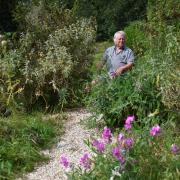Plant specialist Keith Clouting of Taverham Nursery shares his seasonal gardening advice
FLOWERING SHRUBS
Some of the best summer flowering evergreen shrubs are Cistus (Sun or Rock roses) with their succession of flat saucer blooms with thin paper like petals which unfurl on a daily basis over several weeks. One of my favourites and one of the showiest is Cistus x purpureus a variety hybridised in the 18th century.
This compact evergreen shrub has large rich pink flowers with a maroon blotch at the base of each petal, each flower only lasts a short time, but they are produced in good numbers over long period. Another top variety is Cistus x hybridus (syn. Corbariensis) one of the hardiest varieties which forms a low mound of wavy-edged evergreen leaves complemented by small white flowers with yellow stamens which emerge on mass from red buds in June and July.
For larger white flowers try C. x purpureus ‘Alan Fradd’ which has a small rounded bushy habit producing its large white flowers with a maroon blotch at the centre of each petal throughout the summer.
Cistus come from dry rocky areas so prefer well drained soil in full sun, but even if your soil is less than ideal, they might still be worth a try in a sunny spot, if not they also make good container plants.
After flowering trim their foliage lightly back to maintain their shape. Cuttings can also be taken at this time to replace any old or woody plants which have lost their vigour.

PLANT OF THE MONTH
Polygala x dalmaisiana
This amazing long flowering evergreen shrub is a cross between two South African species and although it’s not fully hardy it makes an excellent container plant which can be given a little protection in winter if necessary. It has small glaucous-green leaves topped by delightful bright purple-pink flowers which are produced in abundance throughout the summer and autumn, and with the warmth of a conservatory or greenhouse in cooler weather even longer. It grows best in a sunny position in well-drained soil or compost. Prune back well in spring to maintain shape and prevent the plant becoming leggy.

QUESTION FOR KEITH
had a lovely large flowered Duchess of Edinburgh clematis in my garden which has suddenly collapsed and died back. What is the problem, and can I revive it?
The problem is probably clematis wilt (Calophoma clematidina), unfortunately C. Duchess of Edinburgh is quite susceptible to this disease which mainly attacks large flowered hybrids. You could cut the plant right back to the ground and give it a feed and a good thick mulch, it may well then reshoot from below ground level, but the problem may reoccur. If it does you could replant with one of the smaller flowered varieties which are less susceptible to wilt such as C.montana, C.alpina, C.orientalis and C.viticella among others. When planting large flowered clematis it’s best to plant the rootball five to 10cm below the soil surface to encourage shoots from below ground level which will help the plant recover if it’s unfortunately affected by clematis wilt.
Catch up with Keith
Lavender can be cut for drying now. Choose the newly opened flowers for the best fragrance then hang them in a cool dark place to dry.
Softwood cuttings can be taken from shrubs such as hydrangea, cotinus, pyracantha and laurel.
Check container and basket plants daily. Deadheading, watering and feeding well will keep the show going into late summer.
Regularly sow seeds of short crops such as salad leaves and radishes etc to provide a continuous supply.
Deadhead roses as flowers fade and give them a summer feed to encourage more flowers later in the summer.
If not already done, stake tall growing bulbs such as dahlia, gladiolus and lilies to prevent them blowing over when top heavy in full bloom.
PLUS THE USUAL CONTACT INFO PLEASE



























